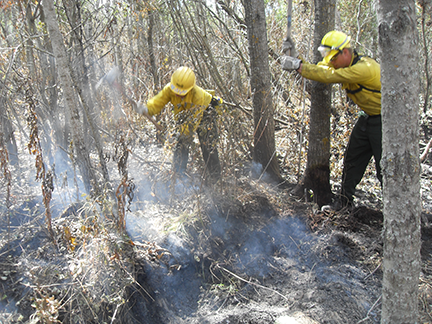Corps crews busy with fall fire season
 Arrowhead crew members Erin McCann and Brian Friedrich digging up smoldering peat while working the Juneberry Road fire in late August.
Arrowhead crew members Erin McCann and Brian Friedrich digging up smoldering peat while working the Juneberry Road fire in late August.
This fall’s drought has created a busy fire season. To date, 120 corps members have been on fire duty, compared to 105 for all of last year. In our northeast district alone, four of six crews have been called out to work fires: Arrowhead, Moose Lake, Tower and Grand Rapids. The Arrowhead crew in particular worked on a couple fires, including the Juneberry Road fire in late August and the Little Manitou fire in early October. On the Juneberry fire, Crew Leader Becky Haug, Field Specialist Darian Motamed and Crew Members Erin McCann, Mike Berg and Brian Friedrich worked for eight days along with three other Corps crews, one from Grand Rapids and two from the Central District. After the initial blaze was brought under control, the fire north of Thief River Falls burned underground, so crew members spent considerable time on mop-up, poking into the ground to uncover smoldering peat. Haug also led the crew that worked the Little Manitou fire northwest of Silver Bay, which included Berg, Friedrich and Tom Vrabel.
DNR Forestry’s strong partnership with the Corps provides an amazing opportunity for corps members to work close up on wildfire and get exposed to aspects of the work that they would not otherwise see. Forestry not only pays for the services we provide, but engages corps members on everything from logistics to initial attack to mop-up. In return, the Corps provides a back-up labor force to supplement the cadre of government agencies involved in wildfire. Though the work is difficult and the schedule uncertain, most corps members look forward to a stint working on a wildland fire. Read more about how crews are trained in fire work.
An expectation of Corps field crew service is that, at any moment, crews could be called out to work on wildfires throughout the state. The on-call schedule rotates between crews, and means that corps members must be ready to deploy within an hour of being called, and could be on site for anywhere between two hours and 14 days. District managers and assistant managers act as duty officers, managing logistics and coordinating deployments, and must be available to take calls at any hour of the day or night during their week on-call.
Crews might work on an initial attack, which involves bringing an outbreak under control, or on mopping up a fire that’s been brought under control, gridding out an area and walking it in a line to check for hot spots. Corps members might also “staff” at a DNR Forestry location so they are ready to quickly step in on initial attack or mop-up.
To prepare, crew members are trained in many aspects of firefighting. As part of their corps training, they take coursework that covers such fundamentals as the Incident Command System (ICS), preparedness and observation, fire shelters, potential hazards on the fireline, tools, firing devices, communication, transportation, water use, suppression, mopup and fire management in urban areas. After completing coursework and fitness testing, corps members receive “red card certification” and are ready to be called out to help with wildfires.
When working on fires, corps members gain direct experience with tools such as pulaskis, bladder bags,fire shelters and Nomex fireproof clothing. They also see firsthand the affect of weather on fire behavior, the different types of fire fuel and the ways to travel around fire. Working with the DNR, Forest Service and other organizations that manage wildland fires, they are exposed to other classes of trucks and equipment and get to take part in debriefing after the fire is out.